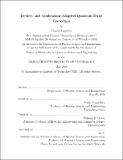Device- and application-adapted quantum error correction
Author(s)
Layden, David.
Download1191905609-MIT.pdf (5.051Mb)
Other Contributors
Massachusetts Institute of Technology. Department of Nuclear Science and Engineering.
Advisor
Paola Cappellaro.
Terms of use
Metadata
Show full item recordAbstract
Precise control of coherent quantum systems could enable new generations of sensing, communication and computing technologies. Such systems, however, are typically noisy and difficult to stabilize. One promising technique to this end is called quantum error correction, which encodes quantum states in such a way that errors can be detected and corrected, much like in classical error-correcting codes. Quantum error-correcting codes usually cast a wide net, in that they are designed to correct errors regardless of their physical origins. In large-scale devices, this is an essential feature. It comes at a cost, however: conventional quantum codes are typically resource-intensive in terms of both the system size and the control operations they require. Yet, in smaller-scale devices the main error sources are often well-understood. In the near term, it may therefore be advantageous to cast a more targeted net through specialized codes. This thesis presents new families of such quantum error-correcting codes, which are adapted either for leading candidate devices, or for near-term applications. The device-adapted codes require exponentially less overhead than conventional codes to achieve the same level of protection, whereas the application-adapted codes can enhance quantum sensors, in which conventional codes cannot readily be used. The new techniques presented in this thesis adapt cornerstones of conventional theory in light of key experimental challenges and opportunities. The ultimate goal of this research is to help bridge the gap between the exacting requirements of proposed quantum technologies and the realities of emerging quantum devices. Bridging this gap is critical, if quantum technologies are to realize their full potential.
Description
Thesis: Ph. D. in Quantum Science and Engineering, Massachusetts Institute of Technology, Department of Nuclear Science and Engineering, May, 2020 Cataloged from the official PDF of thesis. Includes bibliographical references (pages 185-194).
Date issued
2020Department
Massachusetts Institute of Technology. Department of Nuclear Science and EngineeringPublisher
Massachusetts Institute of Technology
Keywords
Nuclear Science and Engineering.